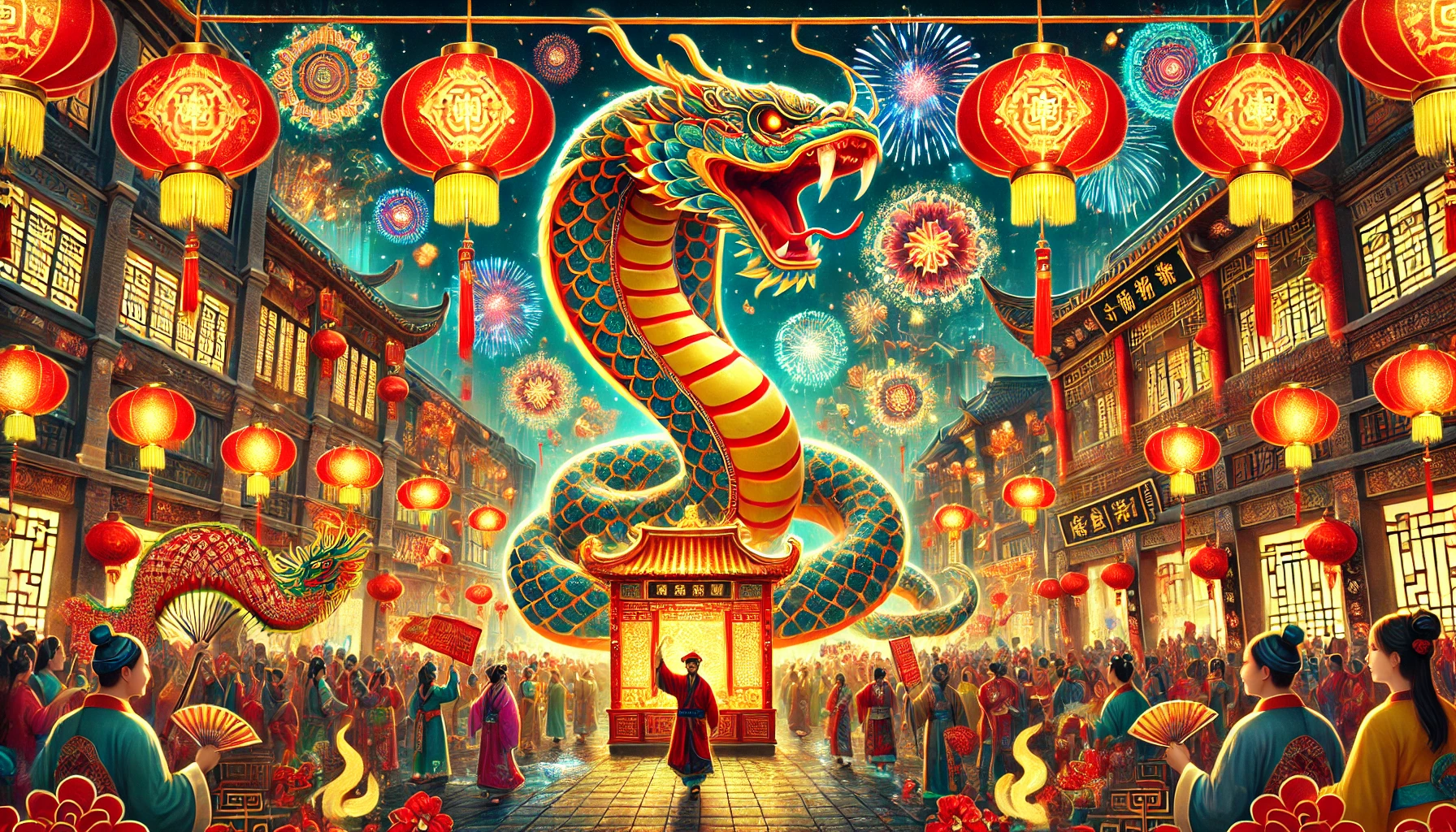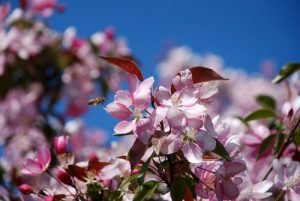
Chinese New Year is a festival that celebrates the beginning of the New Year on the Chinese Calendar. Referred to as the Spring Festival in China it is also known as the Lunar New Year or New Year Festival. Traditionally it was a fifteen day festival ending with the Lantern Festival on the evening of the 15th day. The first day of the Chinese New Year is on the start of the second new moon after the winter solstice. This typically falls between 21st January and 20th February every year however is more likely to be in the early days of February rather than the earlier or later dates.
Table of Contents
- Myths and Legends of Chinese New Year
- Chinese New Year Public holidays
- Chinese New Year’s Eve
- What is the Date of Chinese New Year
- Chinese New Year Festival
- Chinese New Year Second day
- Chinese New Year Third day
- Chinese New Year Fourth day
- Chinese New Year Fifth day
- Chinese New Year Sixth day
- Chinese New Year Seventh day
- Chinese New Year Eighth day
- Chinese New Year Ninth day
- Chinese New Year Tenth day
- Chinese New Year Eleventh day
- Chinese New Year Fifteenth day
- Celebrate Chinese New Year with Joy and Prosperity!
Myths and Legends of Chinese New Year
Mythology states, the beginning of the Chinese New Year celebrations started with a beast called the Nian. The Nian would appear yearly and eat people from the village, especially children. One year, to prevent this, the villagers decided to go hide from the beast. An elderly man appeared before the villagers went into hiding and said that he was going to stay to get revenge on the Nian. The villagers thinking he was mad dismissed him. The old man put red papers up and set off firecrackers all night.
In the morning light, the people came back to their village to see that everything was fine. From this they deduced the old man was probably a God who helped to save them. Given what the deity had done the people learned that the Nian was afraid of the colour red and loud noises. Thus when the New Year was about to come, the villagers would hang red lanterns and red spring scrolls on windows & doors, and wear red clothing. The villagers also used fireworks and firecrackers to scare away the Nian. From then on, the Nian never came to the village again.
Chinese New Year Public holidays
Chinese New Year is observed as an official public holiday in a large number of countries and territories across Asia. As Chinese New Year is based on the Lunar cycle it falls on different dates on the Gregorian calendar every year, some of these public holidays the government opts to shift in order to accommodate a longer public holiday (never fifteen days though.) Typically a public holiday is added on the following work day when the New Year falls on a weekend, as in most of Europe for their New Year’s Day holiday.
Chinese New Year Red envelopes
Traditionally, red envelopes or red packets are given at the new year typically the old give these to the young as a symbol of good luck and to warn off evil spirits. Known as lai see (Cantonese dialect) or angpow (Hokkien dialect/Fujian), or Hongbao (Mandarin)
It is custom for Red packets to contain money, always given in an even amount, as odd numbers are associated with cash given during funerals in China. The number 8 is considered lucky (In Chinese it sounds similar to the word for wealth,) and an amount with 8 is commonly found in the red envelopes. The number six is also considered lucky as it sounds like smooth in the Chinese dialect, in the sense of having a smooth year. Four or giving in groups of four is taboo because its homophone is “death.”
Across Asia, odd and even numbers are determined by the significant digit, rather than the last digit. for example ten and thirty, are odd numbers. Having stated this, it is common and quite acceptable to give cash gifts in a red packet using a single bank note with ten or fifty yuan notes used frequently. Wherever possible the currency should be brand new printed money. As everything regarding the New Year has to be new in order to have good luck and fortune. Sometimes chocolate coins are placed in the red packet for the young or those with no concept of money.
The act of asking for red packets is not a taboo although only within the family generally. A married person would not turn down such a request as it would mean that they would be “out of luck” in the new year. Red packets are generally given by married couples to the younger, unmarried children of the family. It is custom and polite for the children to wish the gifter a happy new year and a year of happiness, health and good fortune before accepting the red envelope. Traditionally the Red envelopes are then placed under their pillow; sleeping on them for seven nights after Chinese New Year before opening as it symbolises good luck and fortune.
Other Traditional Chinese New Year Gifts
Chinese candy box
In addition to red envelopes, which are usually given from older people to younger people, small gifts (typically food or sweets) are also exchanged between friends or in-laws during Chinese New Year. Gifts are usually presented when visiting friends or relatives at their homes. Common gifts include fruits, cakes, biscuits, chocolates and candies.
Certain items are considered bad luck and should not be given. Taboo gifts include:
- Items that show that time is running out (i.e. clocks and watches)
- Sharp objects that symbolise severing a relationship (i.e. scissors and knives)
- Items that symbolise that you want to walk away from a relationship (examples: shoes and sandals)
- Mirrors, thought to attract bad spirits which could make changes for the worse.
- Items associated with funerals (i.e. handkerchiefs, towels, chrysanthemums, items coloured white and black)
- Items that sound similar to unpleasant topics in the local dialect(e.g. In Chinese “clock” sounds like “the funeral ritual”, “handkerchief” sounds like “goodbye”, “pear” sounds like “separate”, and “umbrella” sounds like “disperse”).
Chinese New Year’s Eve
Chinese New Year’s Eve is traditionally the time for the annual reunion dinner. Dishes consisting of special meats are served at the tables, as a main course for the dinner and offering for the New Year. This meal is comparable to Thanksgiving dinner in the U.S. or Christmas dinner.
In the north of China, it is customary to make jiaozi, dumplings after dinner to eat around midnight. Dumplings symbolise wealth because their shape resembles a Chinese Sycee which was an ancient form of currency in China. In contrast, in Southern China, it is customary to make a sweet rice cake (Nian gao) and send pieces of it as gifts to relatives and friends in the following days. Nian Gao literally means “new year cake” and sounds like a meaning of “increasingly prosperous year in, year out.”
Traditionally, in a ritual called “opening the door of fortune” firecrackers were lit to scare away evil spirits with the household doors sealed, not to be reopened until the new morning. Also a tradition of going to bed late on New Year’s Eve, or even keeping awake the whole night and morning, known as shou sui is still practised widely for luck as it is thought to add on to your parents’ longevity.
What is the Date of Chinese New Year
The date of Chinese New Year varies every year based on the Lunar cycle.
| Year | Day | Date | Animal |
|---|---|---|---|
| 2025 | Wednesday | 29th January 2025 | Snake |
| 2026 | Tuesday | 17th February 2026 | Horse |
| 2027 | Saturday | 6th February 2027 | Goat |
| 2028 | Wednesday | 26th January 2028 | Monkey |
| 2029 | Tuesday | 13th February 2029 | Rooster |
| 2030 | Sunday | 3rd February 2030 | Dog |
| 2031 | Thursday | 23rd January 2031 | Pig |
| 2032 | Wednesday | 11th February 2032 | Rat |
| 2033 | Monday | 31st January 2033 | Ox |
Chinese New Year Festival
Traditionally the Chinese New Year or Spring Festival is a fifteen day festival, each day tends to have a different objective or purpose to focus minds and hearts on the year past and in the year coming.
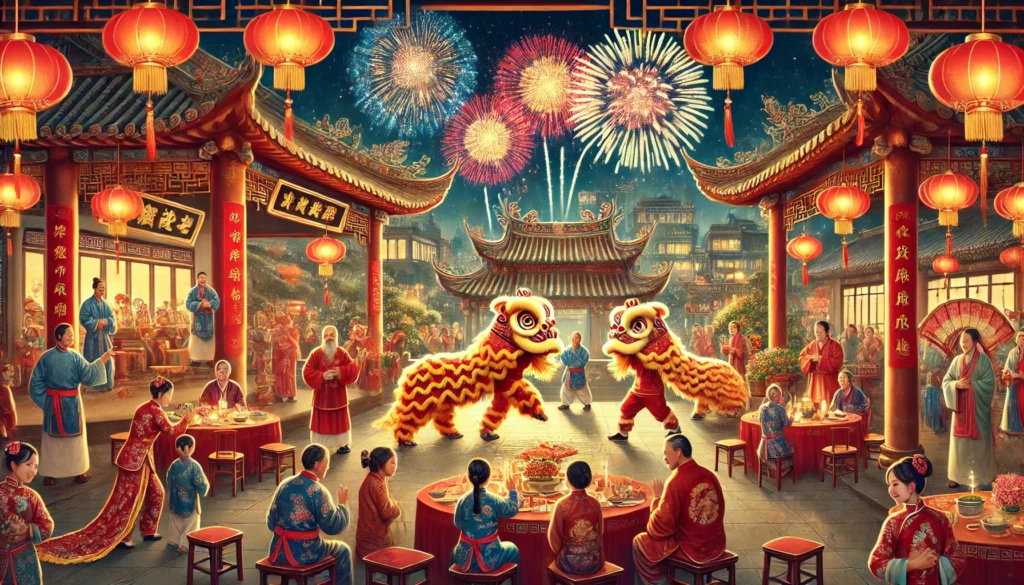
The first day is for the welcoming of the gods of heaven and earth. Officially beginning at midnight, Beijing time it is a tradition to light fireworks, firecrackers and burn bamboo sticks. The purpose is to make as much of a din as possible to chase off the evil spirits as encapsulated by the Nian. Many Buddhists abstain from meat consumption on the first day because it is believed to ensure longevity for them. Some believe lighting fires and using knives on New Year’s Day is bad luck, so any food is cooked in the days before. Another thing to avoid on New Year’s day is the use the broom, as good fortune is not to be “swept away” symbolically.
Most importantly, the first day of Chinese New Year is used to honour one’s elders and families tend to visit the oldest and most senior members of their extended families, usually their parents, grandparents and great-grandparents.
For Buddhists, the first day is also the birthday of Maitreya Bodhisattva (Budai Luohan), the Buddha-to-be.
Families may invite a lion dance troupe as a symbolic ritual to usher in the Chinese New Year as well as to evict bad spirits from the premises. Chinese folklore call this the day of the chicken as when creating all living beings on earth, Nu Wa, a goddess in Chinese mythology, created the six creatures before human beings.
Chinese New Year Second day
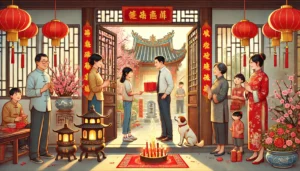
The second day of the Chinese New Year, known as “beginning of the year” was when married daughters visited their birth parents, relatives and close friends. (Traditionally, married daughters didn’t have the opportunity to visit their birth families frequently.) Incense is also burned at the graves of ancestors as part of the offering and prayer rituals. Chinese folklore call this the day of the dog.
Chinese New Year Third day
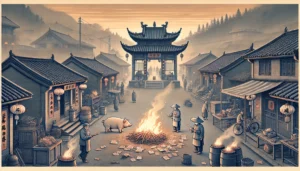
The third day is known as Chigou’s Day. Chigou, literally “red dog”, is also know as the God of Blazing Wrath. Rural villagers continue the tradition of burning paper offerings over trash fires. It is considered an unlucky day to have guests or go visiting. This is also considered an auspicious day to visit the temple of the God of Wealth and have one’s future told. Folklore says the 3rd day is also “rat marriage day”, so people often go to bed earlier to give rats time for their wedding. Chinese folklore call this the day of the pig.
Chinese New Year Fourth day
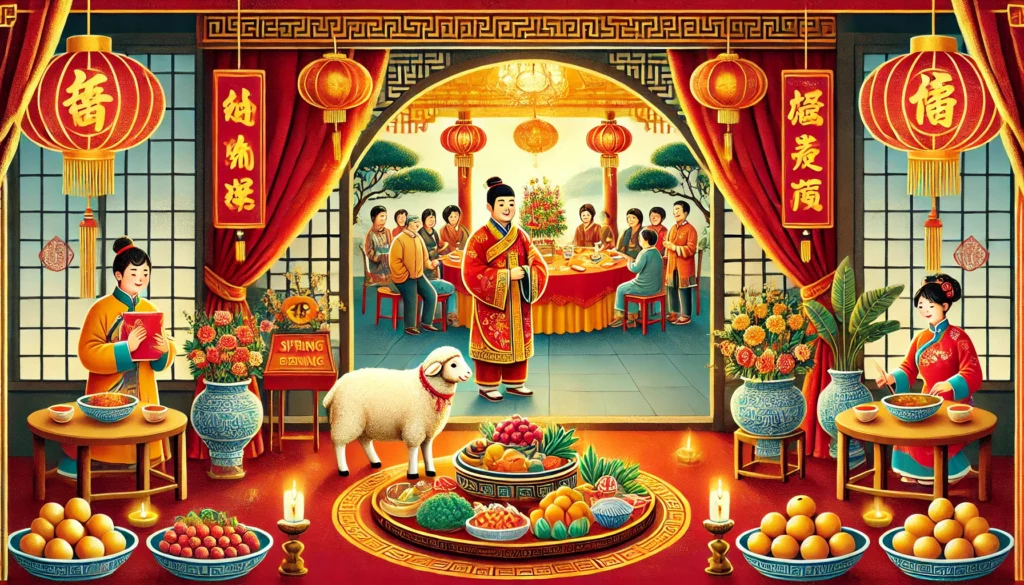
The old saying “three rams bring bliss” is connected with the fourth day, which says that by making a good beginning a happy end comes.
The fourth day is when corporate “spring dinners” kick off and business typically returns to normal. In folklore, it is the day to welcome back the Kitchen God. On this day, the Kitchen God would check the household and therefore people should not leave home. Chinese folklore call this the day of the sheep.
Chinese New Year Fifth day
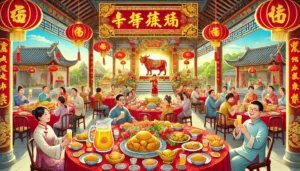
The fifth day is the God of Fortune’s birthday and people may celebrate this day with a large banquet. This day is also commonly known as the Festival of Po Wu, literally breaking five. According to custom, it is believed that many New Year taboos can be broken on this day. Chinese folklore call this the day of the cow.
Chinese New Year Sixth day
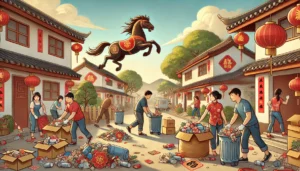
The sixth day is Horse’s Day. People throw out their rubbish stored up during the festival, their ragged clothes and other dirty things. The aim is to drive away the Ghost of Poverty. This reflects the desire of the Chinese people to send away poverty and welcome beautiful days with good luck in the New Year.
Chinese New Year Seventh day
The seventh day, traditionally known as Renri (the common person’s birthday), is the day when everyone grows one year older. People will traditionally eat noodles as they symbolise longevity in Chinese culture. Chinese folklore call this the day of man.
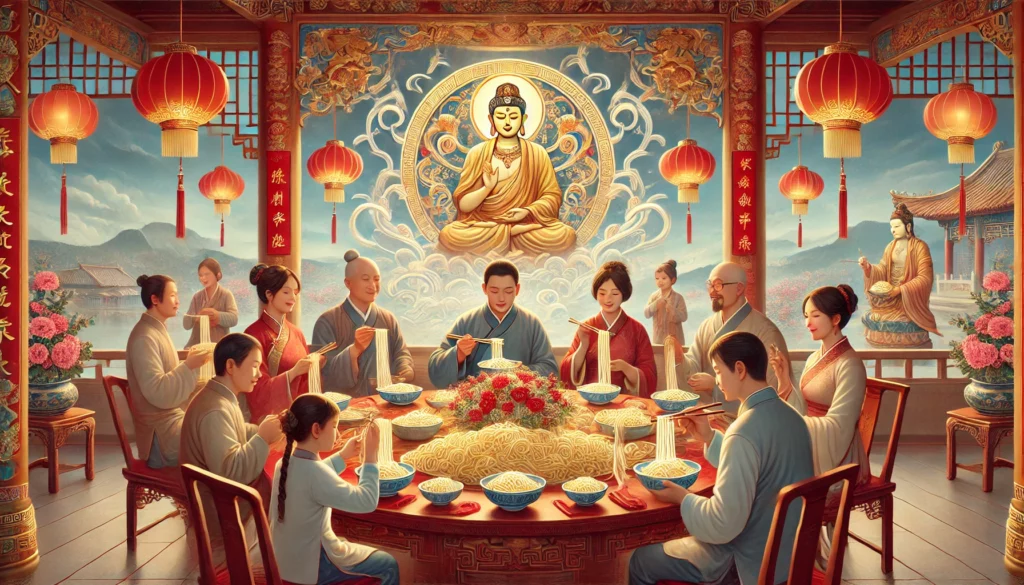
For many Chinese Buddhists, this is another day to avoid meat. The seventh day commemorating the birth of Sakra, lord of the devas in Buddhist cosmology. He is analogous to the Jade Emperor.
Chinese New Year Eighth day
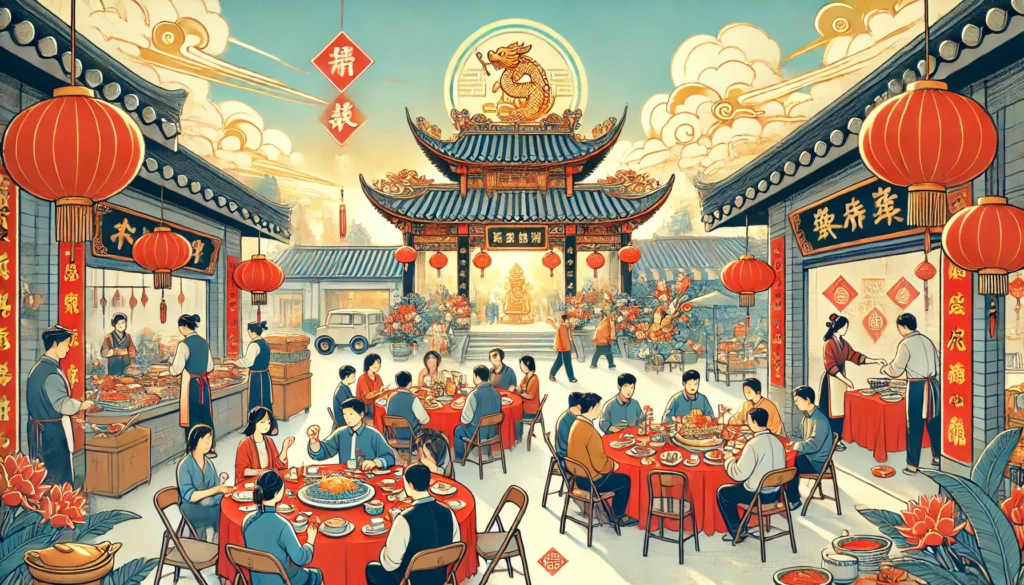
According to Chinese folk proverbs, this day is similar to St Swithin’s Day in the UK, if this day is bright and clear the year will be a harvest year; however, if this day is cloudy or even rainy, the year will suffer from poor harvest.
People normally return to work by the eighth day. Store owners often host a lunch or dinner with their employees. Thanking their employees for the work they have done for the whole year.
Another family dinner may be held to celebrate the eve of the birth of the Jade Emperor, the ruler of heaven.
Chinese New Year Ninth day
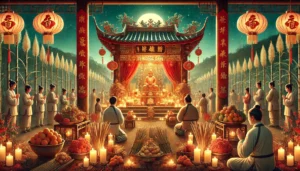
The ninth day of the New Year is a day for Chinese to offer prayers to the Jade Emperor of Heaven in the Daoist Pantheon. The ninth day is the birthday of the Jade Emperor. This day, called Ti Kong Dan, is especially important to Hokkiens, even more important than the first day of the Chinese New Year.
Come midnight of the eighth day of the new year, Hokkiens will offer thanks to the Emperor of Heaven. A prominent requisite offering is sugarcane. Mythology says that the Hokkiens were spared from a massacre by Japanese pirates. They did this by hiding in a sugarcane plantation during the eighth and ninth days of the Chinese New Year. Since “sugarcane” is a near homonym to “thank you” in the Hokkien dialect, Hokkiens offer sugarcane on the eve of his birthday, symbolic of their gratitude.
There will be grand ceremonies in Taoist temples on this day, and ordinary families may also offer sacrifices to the Jade Emperor.
Chinese New Year Tenth day
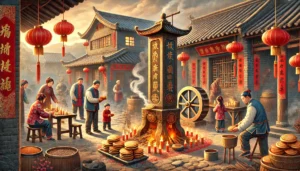
The 10th day is believed to be the birthday of the God of Stone whom played a very important role in the rural society of ancient China.
On this day, people were forbidden to move any stone, including stone rollers, stone mills and herb grinders, and would not cut into a mountain for rock or build a house with rocks, otherwise bad things will happen to their crops. Incense and candles were also burned for the stones and offer pancakes to the God of Stone.
Chinese New Year Eleventh day
This day is for fathers-in-law (Yuefu ) to entertain sons-in-law (Nuxu.) People may also make offerings to Zi Gu, the guardian angel for wronged women, on the 11th day, A Goddess also known as the Goddess of Toilets. She appears in the form of a beautiful woman, her lower body wrapped in clouds. Rather this than sitting on the throne!
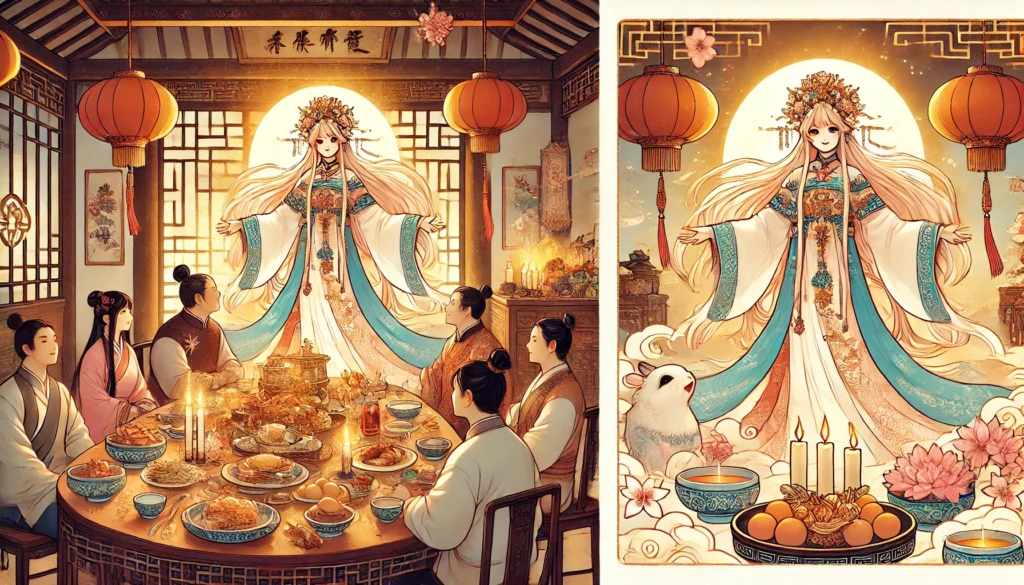
In many areas of China, after this day, people will prepare for the Lantern Festival marking the end of the celebrations.
Chinese New Year Fifteenth day
The fifteenth day of the new year is celebrated as Yuan Xiao Jie. Also known as “Shangyuan Festival” or the Spring Lantern Festival. Rice dumplings (tang yuan), a sweet glutinous rice ball cooked in a soup, are eaten this day. Since early morning, dragon and lion dancers parade on streets. In the evening families go out together to enjoy the full moon, appreciate colourful lanterns and also solve lantern riddles. In ancient times, the lanterns were fairly simple, and only the Emperor and noblemen had large ornate ones. Candles are lit outside houses as a way to guide wayward spirits home. The lanterns are almost always red to symbolise good fortune.
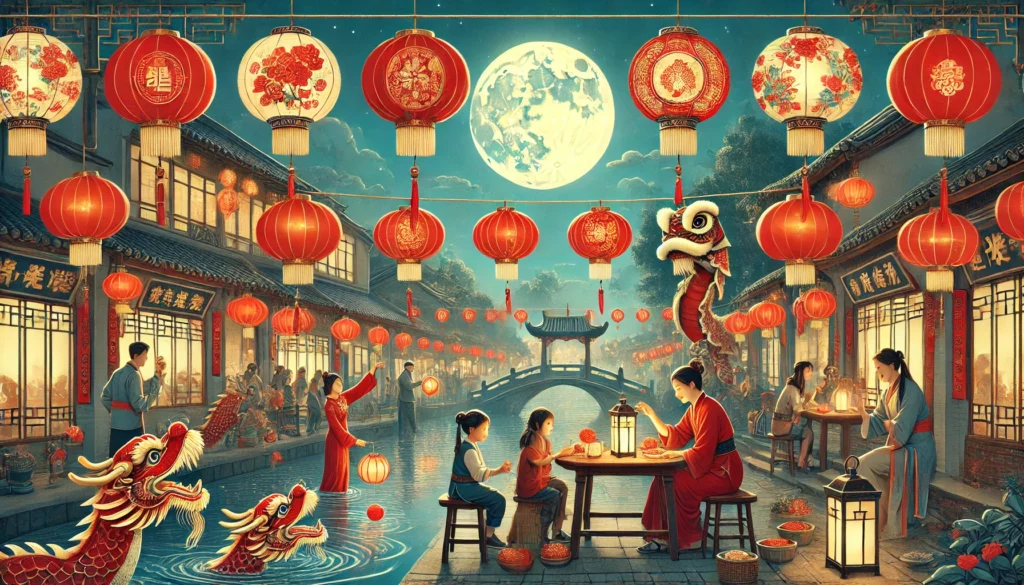
In China, Malaysia, and Singapore, this day is celebrated by individuals seeking a romantic partner, akin to Valentine’s Day. Single women typically write their contact number on mandarin oranges, throw them in a river or a lake for single men to collect and eat them. The taste is an indication of their possible love: sweet represents a good fate while sour represents a bad fate.
This day officially marks the end of Chinese New Year celebrations.
Celebrate Chinese New Year with Joy and Prosperity!
As we welcome the Year of Snake, embrace the traditions, share delicious meals, and create unforgettable memories with loved ones. Whether you’re planning your first celebration or looking to deepen your understanding of this rich cultural festival, there’s something magical for everyone in these 15 days of joy.
We’d love to hear from you! What are your favourite Chinese New Year traditions, or do you have any special ways of celebrating? Share your thoughts in the comments below, and don’t forget to explore our collection of unique gift ideas for every festive occasion.
Make this Chinese New Year truly special – spread the joy by sharing this article with friends and family!

